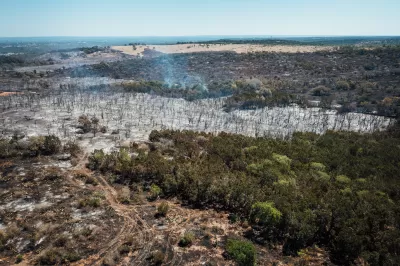Sprawl in and around Austin is contributing to growing wildfire risks, and local officials worry about a lack of public awareness of the issue.

Fire risk is making its way from California to Texas along with tech companies and workers looking for more affordable housing, writes Patric Sisson in Bloomberg CityLab. As developers build more communities in the Austin suburbs to accommodate the growing population, neighborhood sprawl is increasingly encroaching on local forests.
“In general, the wildfire peril in Texas can’t compare to that in California, which is among the highest in the world, said Sam Carter, founding principal of Resilient Cities Catalyst.” But Austin city council member Alison Alter says “The fire risk in Austin is pretty serious, and I don’t think there’s a level of awareness that there is in California.” According to the article, over one third of Austin is at ‘high risk’ of fire.
Austin has experienced its own deadly fires in the past: “In 2011, nearly 1,700 buildings were destroyed when a wildfire tindered by downed power lines raced through drought-parched subdivisions in Bastrop County, southeast of Austin. More than 30,000 acres burned and two people were killed.” Conditions can be made worse by other natural disasters such as ice storms and deep freezes like the one that damaged infrastructure and felled trees and power lines across Texas in 2021.
“Creating a more fire-resilient central Texas would require a holistic approach and a lot of coordination between property owners: Unlike California, with its massive stock of state and national forests preserves and parks, 90% of Texas land is privately owned.” And while there is little optimism that builders will stop building, some cities are developing fire protection plans and coordinating fire response policies to prepare for future blazes.
FULL STORY: One More Thing Moving From California to Texas: Wildfire Risk

Planetizen Federal Action Tracker
A weekly monitor of how Trump’s orders and actions are impacting planners and planning in America.

San Francisco's School District Spent $105M To Build Affordable Housing for Teachers — And That's Just the Beginning
SFUSD joins a growing list of school districts using their land holdings to address housing affordability challenges faced by their own employees.

The Tiny, Adorable $7,000 Car Turning Japan Onto EVs
The single seat Mibot charges from a regular plug as quickly as an iPad, and is about half the price of an average EV.

Trump Approves Futuristic Automated Texas-Mexico Cargo Corridor
The project could remove tens of thousands of commercial trucks from roadways.

Austin's First Single Stair Apartment Building is Officially Underway
Eliminating the requirement for two staircases in multi-story residential buildings lets developers use smaller lots and more flexible designs to create denser housing.

Atlanta Bus System Redesign Will Nearly Triple Access
MARTA's Next Gen Bus Network will retool over 100 bus routes, expand frequent service.
Urban Design for Planners 1: Software Tools
This six-course series explores essential urban design concepts using open source software and equips planners with the tools they need to participate fully in the urban design process.
Planning for Universal Design
Learn the tools for implementing Universal Design in planning regulations.
Smith Gee Studio
City of Charlotte
City of Camden Redevelopment Agency
City of Astoria
Transportation Research & Education Center (TREC) at Portland State University
US High Speed Rail Association
City of Camden Redevelopment Agency
Municipality of Princeton (NJ)



























